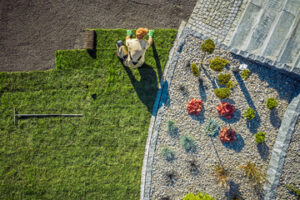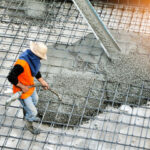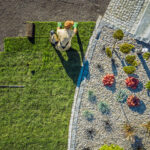Landscaping Greensboro NC is more than just curb appeal or “keeping up with the Joneses.” Well-planned and expertly executed landscaping increases property value, provides functional outdoor areas, and reduces maintenance.

Plants provide color, texture and movement in the landscape. Using plants as barriers helps define space and block views, while providing shade and visual intrigue.
Landscapers use a variety of plants to create aesthetically pleasing outdoor spaces. They also use hardscaping elements like paths, patios, and retaining walls to add structure to the landscape. The most important aspect of landscaping is choosing plants that suit the climate and soil conditions of the site. Native plants are often a good choice, as they are adapted to local environmental conditions and can help support wildlife.
A well-designed garden will enhance a home’s beauty and increase its value. It will also provide privacy, protect against wind and noise, and reduce energy costs by shading windows and doors. In addition, a properly maintained landscape can improve air quality by removing pollutants and carbon dioxide from the environment. It can also create habitats for birds and other wildlife.
People value green space and time spent outdoors immensely; perhaps more than they realize. Many cities have parks and other public green spaces that serve a multitude of purposes, from recreation to rest to meditation. Without the work of landscaping professionals, these green spaces would quickly become overgrown and unappealing.
For businesses, sustainable landscaping can reinforce a company’s commitment to environmental stewardship. It can also attract eco-conscious customers and employees.
The most common way that landscaping improves the quality of life is through the creation of green spaces and gardens, both residential and commercial. The practice of creating beautiful, functional outdoor spaces is not a new concept; it has been around since ancient civilizations began manipulating the land to cultivate crops and create gardens. Modern technology is now being used to make the landscaping process even more efficient and environmentally friendly. For example, smart-lighting systems can automatically turn off lights when a space is not being used, reducing energy consumption and eliminating waste.
Water
The tranquil sounds of a serene pond or the soothing sight of a gentle stream can transform your backyard into an outdoor oasis. The beauty of a water feature can also add value to your home if you decide to sell in the future. Current real estate trends show a growing demand for homes with backyard retreats that offer relaxation, entertainment, and connection to nature. Water elements add value to your property and make your backyard a unique place that will stand out from other listings in the neighborhood.
Adding a water feature to your landscape offers boundless opportunities for creativity and design. From traditional options like ponds and streams to contemporary designs such as fountains and bubblers, water features are dynamic focal points that add sophistication to your landscaping. Customization allows you to create a one-of-a-kind feature that matches your aesthetic and complements the existing landscape design of your home.
Aside from their visual appeal, water features have a number of health and wellness benefits that can improve your quality of life. The sound of running water is soothing and has been shown to lower blood pressure and heart rate, reducing feelings of stress and anxiety. Water features can also provide a natural habitat for birds and other wildlife, making them a wonderful addition to your backyard.
The type of plants and trees you choose can significantly impact how much water is used by your water feature. Plants that are native to your area or drought-resistant help decrease the need for excessive irrigation, preserving natural resources. You may also consider incorporating water-wise features into your design, such as rainwater harvesting and graywater reuse, to further reduce your water usage.
Lighting
A well-lit landscape is one of the best ways to increase your property’s value. It can showcase the architectural details of your home, the vibrant colors of your flower beds and garden, or the grandeur of your trees even after sunset. The addition of lighting also makes your space safer for guests who want to walk around after dark. Properly placed lighting can clearly mark pathways and stairs to prevent tripping and falling, and deter unwanted visitors by illuminating areas that could potentially be used as hiding spots.
The style of the lights you choose should be consistent with the design aesthetic of your landscaping and home, ensuring that they look cohesive and intentional at night. Lights can be installed in a variety of ways, including silhouetting (where the light is angled in front of an object to create a shadow effect), uplighting (to highlight the height and structure of trees or other features), and washing (where the light is positioned underneath objects to produce a soft, moonlit glow).
In addition to creating a beautiful ambiance, lighting can help to protect your investment by deterring unwanted intruders. Motion-activated lights can be used to brighten walkways and entries as soon as they detect movement, helping to keep trespassers and vandals at bay. The addition of lighting also makes your home more appealing to prospective buyers, who will appreciate the safety and security features that come with a well-lit landscape.
Finally, lighting options like LEDs are energy-efficient and eco-friendly, making them a great choice for those concerned with reducing their environmental impact. They use up to 85% less energy than traditional incandescent bulbs and last much longer, which means they can reduce your energy costs and maintenance needs over time.
Softscapes
The softscapes are the living, horticultural elements in your landscape that add color, texture, and dynamism. They include trees, shrubs, flowers, grass, and soil. A well-designed softscape can create a tranquil natural oasis that you can retreat to whenever you want to relax and enjoy the outdoors.
Softscape elements also help with the flow and function of your landscape. Pathways and patios make it easy to move around the space, while retaining walls and fences delineate boundaries and offer privacy. Water features and fire pits enhance the ambiance of your outdoor space, while pergolas, gazebos, and arbors provide vertical interest to the landscape and can be adorned with climbing plants.
A properly designed softscape can add beauty to your home while also increasing its value and curb appeal. However, it is important to keep in mind that these elements will need some level of maintenance throughout the year. For example, flowers require yearly replacement and trees need regular pruning. Therefore, it is crucial to include a balanced ratio of hardscape and softscape features in your design plan.
Maintaining a Balance
Softscapes can become a jungle if left unattended. For example, if you have a vegetable garden, rose gardens, succulents, fruit trees, and topiary all growing in a chaotic manner, your backyard will look like a jungle instead of a relaxing place to spend time. To avoid this, you need to have a clear vision of what you want your yard to look like and select appropriate plant varieties.
The contrasting textures of hardscape and softscape elements create a beautiful aesthetic. The right combination of both can take your landscape to the next level and impress family, friends, and neighbors.
Maintenance
After the landscape is designed and built, it needs to be properly maintained to keep up its appearance and functionality. Regular lawn mowing, edging, trimming, mulching, pest control and watering keep the plants healthy, reduce weed growth, promote plant growth and increase overall appearance.
Proper landscaping maintenance also includes hardscapes, such as paths, patios, retaining walls and garden edging. Inspecting these elements for deterioration, damage or dislodgement is an important part of landscape maintenance and ensures that they look pristine. This also helps to prevent costly repairs and replacements in the future.
In addition to enhancing the beauty of property, well-maintained landscaping increases a home’s value and makes it more enjoyable for residents and visitors to spend time outdoors. It’s also been shown that outdoor activities like gardening and yard work can improve mental health and lower stress levels, so it’s no wonder why more people are choosing to live in communities with lush green spaces.
Residential and commercial landscaping has the added benefit of providing a habitat for local wildlife. Incorporating plants that are native to the area helps conserve water and maintain balanced ecosystems. The use of xeriscaping techniques and drip irrigation can also help to reduce water usage and the need for chemical pesticides.
Developing and maintaining a proper landscape requires a substantial amount of time and resources, so it’s essential to plan ahead. Having an organized maintenance checklist helps to reduce costs and ensure that your landscape is functioning at its best all year round. If you’re struggling to convince management to prioritize landscape maintenance, present them with key impact data and visuals that show how a well-maintained landscape boosts customer satisfaction, increases property values and fosters community well-being.




